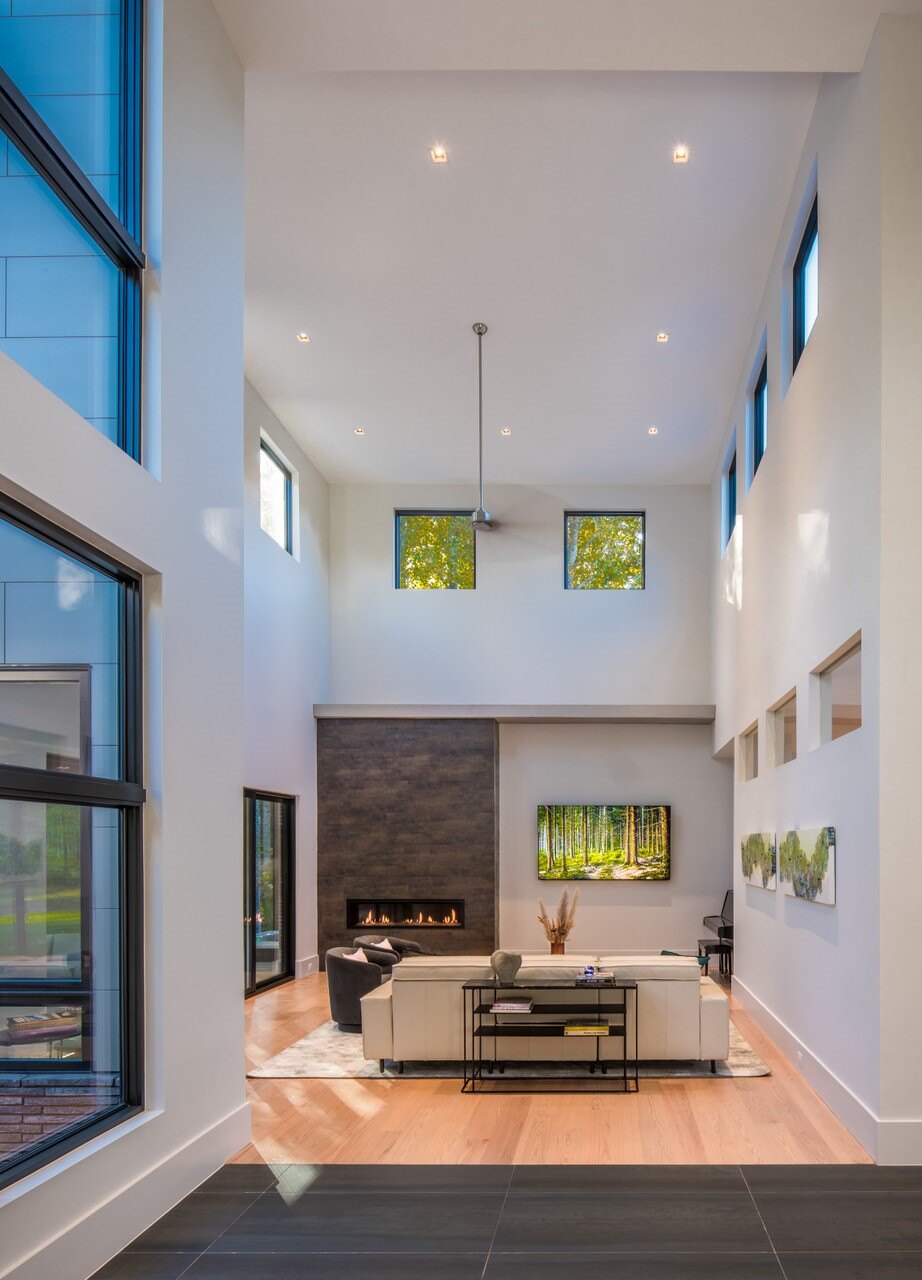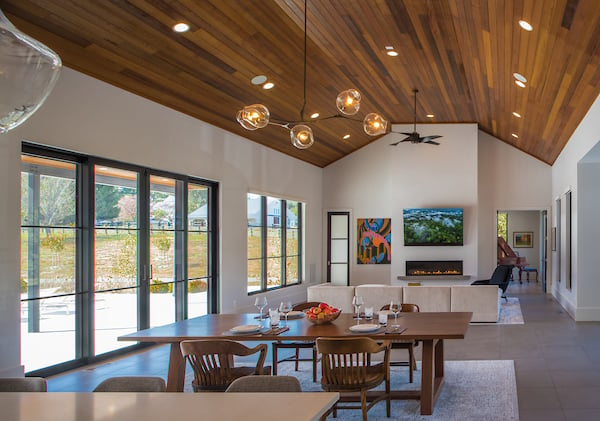
Ceilings do more than close off a room. They shape how a space feels, how light travels, and how your home’s architecture tells its story. In Northern Virginia, where custom homes carry both elegance and function, the question of ceiling height isn’t simple. Too low and the space feels tight. Too high and it risks losing warmth.
Homeowners often picture soaring ceilings with chandeliers that wow guests. But height without balance can turn dramatic into uncomfortable. It can also impact energy use, acoustics, and how you furnish the space. What looks beautiful in a magazine doesn’t always translate into livable comfort.
This is where expertise matters. At AV Architects + Builders, we guide clients through these decisions with a blend of technical knowledge and design vision. We understand that beams, light, and proportion all change how a ceiling feels. Our goal is to create homes that look stunning but also serve daily living.
By the end of this guide, you’ll see the difference between height that elevates your home and height that overwhelms it. You’ll learn how to use beams and lighting for visual drama, when high ceilings work best, and how to avoid common pitfalls. Most importantly, you’ll know how to choose a design that fits your lifestyle.
 The Vista House, Great Falls, Virginia, AV Architects + Builders, Photography by Maxwell Mackenzie
The Vista House, Great Falls, Virginia, AV Architects + Builders, Photography by Maxwell Mackenzie
Is There a Standard Ceiling Size?
Traditional homes often feature 8-foot ceilings, which used to be the accepted norm. Over the years, builders shifted toward 9 feet, and in many new builds, main living spaces now stretch to 10 or 12 feet. These shifts reflect changes in design preference and construction standards. Design guides note how these norms have shifted, while construction material references explain how practicality shapes what’s possible.
The right height depends on context. A 14-foot ceiling can feel luxurious in a great room, yet out of place in a small bedroom. Studies suggest ceiling height influences not only aesthetics but also how people perceive openness and comfort.
How Tall is Tall?
The ceiling starts to feel tall at 12 feet. Beyond that, height transforms into grandeur, especially in living rooms and foyers that often range between 14 and 20 feet. Tall ceilings create visual drama, but they also require careful planning for balance. Without proportion and detail, a tall space risks looking hollow.
Benefits of Having a High Ceiling
According to design experts, high ceilings offer distinct advantages:
- More daylight when paired with large windows
- A sense of openness and airiness
- Space for beams, coffers, or statement lighting
- Better airflow and ventilation
- Higher perceived value in the market
The Fear of Having High Ceilings
Concerns about heating and cooling costs are common. Tall spaces hold more air, which demands more from HVAC systems. But modern solutions make large volumes easier to manage. Energy studies highlight how building design impacts thermal comfort, and insulation strategies often help control costs.
Another fear is coziness. Some homeowners worry high ceilings feel cold or impersonal. Yet design techniques like layered LED lighting can create intimacy in even the tallest spaces.
When and When Not to Have High Ceilings
High ceilings shine in gathering areas like living rooms, foyers, and entertainment spaces. They don’t always fit bedrooms, libraries, or offices where calm and enclosure matter more than openness. Home myths often push buyers toward grandeur, but real estate insights show scale has to be tied to purpose.
So, To Answer the Question,
How tall is too tall? Too tall is when the height no longer matches the function or feeling you want. A ceiling isn’t measured only in feet, but in proportion, comfort, and livability.
A Deep Dive into Ceiling Heights, Beams, and Visual Drama
Beams bring rhythm and grounding to open spaces. Without them, expanses of ceiling can feel empty. Coffered designs or reclaimed wood details add weight and texture that prevent rooms from looking cavernous. Architectural studies reinforce the idea that structure influences how people emotionally respond to space.
Lighting and Design Flexibility
Tall ceilings offer unmatched freedom in lighting. Layered design, with chandeliers, pendants, and sconces, sets both mood and function. Lighting strategies combine efficiency and atmosphere to keep large spaces both beautiful and livable.
Do High Ceilings Mean You Need a Big Chandelier?
Not always. The key is proportion. A single oversized chandelier can dominate a space, while multiple pendants may add more balance. Lighting should enhance the architecture, not overpower it.
How to Make a High Ceiling Look Beautiful
Design choices define whether a tall ceiling feels intentional or awkward:
- Use layered lighting for warmth and variety
- Add architectural details like beams or coffers
- Bring in floor-to-ceiling curtains or tall art
- Choose bold accent walls for balance
- Scale furniture up so it doesn’t disappear in the volume
Interior pros recommend balancing textures, colors, and proportions to bring personality into large spaces.
Acoustics and Comfort
Echoes often occur in tall rooms, especially with hard flooring and minimal fabric. Acoustic design helps soften sound and keep conversations natural. Rugs, upholstered furniture, and curtains also work as practical fixes.
Energy Use and Efficiency
Tall ceilings create more air volume, which challenges heating and cooling systems. Advances in insulation and energy planning paired with ceiling fans and smart zoning, keep costs manageable. This balance of comfort and efficiency is key in designing homes with dramatic height.
Resale Considerations
Homes with higher ceilings often stand out in listings. Buyers associate height with luxury, but preferences differ. Some value intimacy over scale. That’s why ceiling height works best when balanced with room function and overall flow.

The Woodlands House, Great Falls, Virginia, AV Architects + Builders
Designing Height With Purpose
Elevating ceilings is a delicate mix of art, science, and practical design. At AV Architects + Builders, we focus on creating spaces where height enhances comfort, style, and functionality. Every beam, every foot of vertical space is deliberate, ensuring your home feels intentional and harmonious. Schedule a discovery call today or visit our Learning Center to explore our designs, see real-life examples, and plan a home that balances drama with livability.
Topics:



